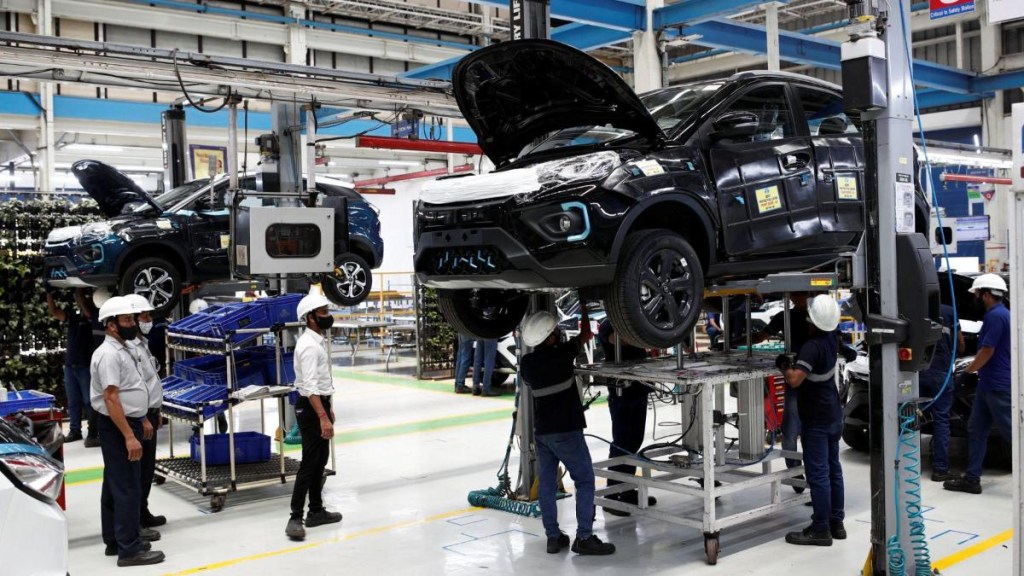The country’s auto companies have taken the superfast track on the road to expansion. In an indication of how confident they are about the demand trajectory, they have committed close to Rs 3-trillion investments in the next 7-10 years. Crisil estimates that around Rs 85,000 crore will be spent by FY26. That’s about 1.6 times the investment of Rs 53,000 crore in the last three financial years.
The spends are not surprising given that Crisil estimates demand for passenger vehicles to grow at a compound 4.5-6.5% between FY24 and FY29 to reach 5.2-5.7 million units. Electric vehicles (EVs) are becoming increasingly popular – sales in FY24 at 1.67 million were 21% higher than in FY23.
The Tata Motors management expects commercial vehicle (CV) volumes to grow at a compound 4-5% over the next 5 years. It also believes the CV industry is likely to be less cyclical now as there are no major new regulations expected. Rishi Vora, analyst at Kotak Institutional Equities (KIE), believes CV volumes would be led by a 5% compound growth in M&HCVs and a compound 7% CAGR in LCV volumes, taking the combined growth rate to 6% over FY24-27.
While the 10-year growth rate for two-wheelers has been a compound 2%, demand is expected to pick up on the back of a rural recovery. TVS believes the uptick in rural demand could benefit not just the entry level but also the executive and premium segments.
Vora expects domestic two-wheeler volumes to increase at a compound 8-9% over FY25-26 driven by strong growth in the 125 cc segment and pick-up in EV volumes. Retail sales of ICE two-wheelers in FY24 stood at 17.51 million units, up 9.3% over FY23.
The bulk of the capex, or roughly two-thirds, will be incurred by legacy heavyweights Maruti Suzuki, Tata Motors and Mahindra & Mahindra (M&M). Supplementing their efforts will be startups and foreign firms like Vinfast and Ola Electric in the EV space.
Maruti Suzuki has indicated it wants to have a capacity of 4 million units by 2030-31 even as it enhances its suite of products to 27-28 – including hybrids and EVs – from 17 currently. To achieve this, it must add two million units of capacity in the next 7 years; some of this would be used to roll out hybrids, EVs and cars that run on CNG, ethanol and compressed biogas.
Tata Motors has said it plans to put some Rs 16,000-18,000 crore to work in the next 7 years to manufacture EVs. The company will invest around 6-8% of its FY24 revenues of Rs 52,400 crore in ICE PVs. In addition, it proposes to invest 2-4% of its FY24 revenues from commercial vehicles of close to Rs 80,000 crore in the trucks and buses business. Meanwhile, Hyundai India has said it will commit Rs 32,000 crore as it develops an EV platform in the country and builds a supply chain to localise the production of components.
Outlining Mahindra & Mahindra’s plans, executive director Rajesh Jejurikar has said the company is developing both ICE and EV portfolios. M&M intends to invest around Rs 27,000 crore in the next few years and is targeting 23 launches by 2030 across SUVs and LCVs. “It is how we want to drive globalisation over the next 6-7 years. We need products which are going to be globally competitive,” Jejurikar said.
Much of the money, it would appear, is being channelled into the manufacture of passenger cars. Investments in the two-wheeler segment are estimated at Rs 5,000-5,500 crore through FY26 and will be used to add capacity, develop products and technology. Capital commitments for the CV segment are expected to be in the region of Rs 4,000-4,500 crore.
According to industry body Automotive Component Manufacturers Association (ACMA), the sector is set to invest Rs 58,000 crore by FY28 to deepen localisation of advanced components from electric motors to automatic transmissions to reduce imports and capitalise on multinationals’ ‘China Plus One’ sourcing strategy.
As S Krishnamurthy, senior VP, Icra, pointed out that the good news is that a sizeable part of the capex would be met from cash accruals, cash and liquid investments and parent-funded support. “The increase in leverage is unlikely for most of the manufacturers,” he said.


















